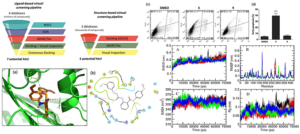Publicamos um novo artigo na revista International Journal of Biological Macromolecules (IJBM, fator de impacto de 5,16) intitulado Identification of novel αβ-tubulin modulators with antiproliferative activity directed to cancer therapy using ligand and structure-based virtual screening.
O artigo corresponde a parte da tese de doutorado de Leonardo B. Federico, atualmente pós doutorando do LCQF. O manuscrito contou com a colaboração de membros do LCQF, bem como de parcerias externas nacionais e internacionais: Fabrício Figueiró (Institute of Health Sciences, UFRS), Cleydson Breno Rodrigues dos Santos (Department of Biological and Health Sciences, UNIFAP), Luciano T. Costa (MolMod-CS, Institute of Chemistry, Federal Fluminense University) e Joaquín Maria Carmpos Rosa (Department of Pharmaceutical and Organic Chemistry, University of Granada).
Abstract: Among several strategies related to cancer therapy targeting the modulation of αβ-tubulin has shown encouraging findings, more specifically when this is achieved by inhibitors located at the colchicine binding site. In this work, we aim to fish new αβ-tubulin modulators through a diverse and rational VS study, and thus, exhibiting the development of two VS pipelines. This allowed us to identify two compounds 5 and 9 that showed IC50 values of 19.69 and 21.97 μM, respectively, towards possible modulation of αβ-tubulin, such as assessed by in vitro assays in C6 glioma and HEPG2 cell lines. We also evaluated possible mechanisms of action of obtained hits towards the colchicine binding site of αβ-tubulin by using docking approaches. In addition, assessment of the stability of the active (5 and 9) and inactive compounds (3 and 13) within the colchicine binding site was carried out by molecular dynamics (MD) simulations, highlighting the solvent effect and revealing the compound 5 as the most stable in the complex. At last, deep analysis of these results provided some valuable insights on the importance of using mixed ligand- and structure-based strategies in VS campaigns, in order to achieve higher chemical diversity and biological effect as well.
Confira mais aqui: https://doi.org/10.1016/j.ijbiomac.2020.10.136


